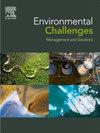Harnessing microbes and plants for bioremediation of heavy metal contaminants: Current paradigms and future perspectives
Q2 Environmental Science
引用次数: 0
Abstract
The increasing contamination of the environment by heavy metals from industrial, agricultural, and urban activities cause significant risks to the ecosystems and human health. Heavy metals are toxic to aquatic life, plants, and microorganisms, worsening environmental degradation. However, various species have evolved natural detoxification mechanisms, making bioremediation an attractive strategy for environmental preservation. Bioremediation harnessing the natural detoxification capabilities of microorganisms and plants, has emerged as a sustainable and environment friendly alternative to traditional remediation methods. Microorganisms, particularly bacteria employ metabolic pathways to transform or sequester toxic metals, reducing their bioavailability, while certain plants uptake and accumulate heavy metals in their tissues for phytoremediation. The combined use of microbial consortia and plant systems enhances metal detoxification, stabilization, and uptake, offering improved efficiency across various environmental conditions. This study provides a comprehensive account of the recent advancements in the use of microorganisms and plants as sustainable strategies to detoxify heavy metal contaminants. It discusses the potential mechanisms employed by the microbes and plants to mineralize these emerging pollutants in the environment. Further we weigh the pros and cons of the plant and microbe-based remediation strategies, emphasizing their potential integration with conventional methods to develop comprehensive, sustainable solutions for heavy metal pollution control.

利用微生物和植物进行重金属污染物的生物修复:当前范例和未来展望
来自工业、农业和城市活动的重金属对环境的污染日益严重,对生态系统和人类健康造成重大风险。重金属对水生生物、植物和微生物有毒,加剧环境退化。然而,各种物种已经进化出自然解毒机制,使生物修复成为一种有吸引力的环境保护策略。生物修复利用微生物和植物的自然解毒能力,已成为传统修复方法的一种可持续和环境友好的替代方法。微生物,特别是细菌通过代谢途径转化或隔离有毒金属,降低其生物利用度,而某些植物在其组织中吸收和积累重金属以进行植物修复。微生物群落和植物系统的结合使用增强了金属的解毒、稳定和吸收,从而提高了在各种环境条件下的效率。本研究全面介绍了利用微生物和植物作为可持续策略来解毒重金属污染物的最新进展。它讨论了微生物和植物在环境中矿化这些新污染物的潜在机制。此外,我们还权衡了植物和微生物修复策略的利弊,强调了它们与传统方法相结合的潜力,以开发全面、可持续的重金属污染控制解决方案。
本文章由计算机程序翻译,如有差异,请以英文原文为准。
求助全文
约1分钟内获得全文
求助全文
来源期刊

Environmental Challenges
Environmental Science-Environmental Engineering
CiteScore
8.00
自引率
0.00%
发文量
249
审稿时长
8 weeks
 求助内容:
求助内容: 应助结果提醒方式:
应助结果提醒方式:


